Oviedo is the capital of Asturias. The inhabitants of the city have the beautiful name “Ovetenser”.
The city was built on the hill that the Romans called Ovetao. In 761, a monk founded a monastery directly on a road that connected León with Lugo de Llanera. It was not long before other monks joined him and elected an abbot.
In 812, Alfonso II moved the capital to Oviedo and elevated the city to the status of a bishopric. During the reign of the ruler, a grave was discovered in Santiago de Compostela and the body was claimed to be that of St. James the Elder. The king then moved from Oviedo to Santiago de Compostela and “opened” the first Way of St. James as the first pilgrim. The Way of St. James led to an economic boom in the city that lasted throughout the Middle Ages.

The old town of Oviedo
A stroll through the pedestrian zone of the old town is really worthwhile. There is a lot to discover, such as the university buildings, the Palace of the Marquis of San Félix, the Composagrado Palace and, of course, the Cathedral of San Salvador. Those who prefer a more artistic tour of the city should go in search of the countless sculptures that can be seen in the cityscape.
Oviedo Cathedral
The Cathedral of San Salvador stands tall and mighty in the middle of Oviedo. Today it is the main church of the northern Spanish archdiocese of Oviedo.
The first church building was commissioned by the Asturian King Fruela I. The exact date cannot be determined, but there are indications that the building was destroyed in 794.

Alfonso II ordered the construction of a new church as part of his appointment as bishop. At 40 x 20 meters in size and around 25 meters high, the church building was very impressive for its time.
In the 12th century, this church was replaced by a cathedral in the Romanesque style. Scientists have been able to find a few structural remains from the past. The Torre Vieja, which was built in the 11th century for defensive purposes, was converted into a bell tower and now fulfilled other functions.
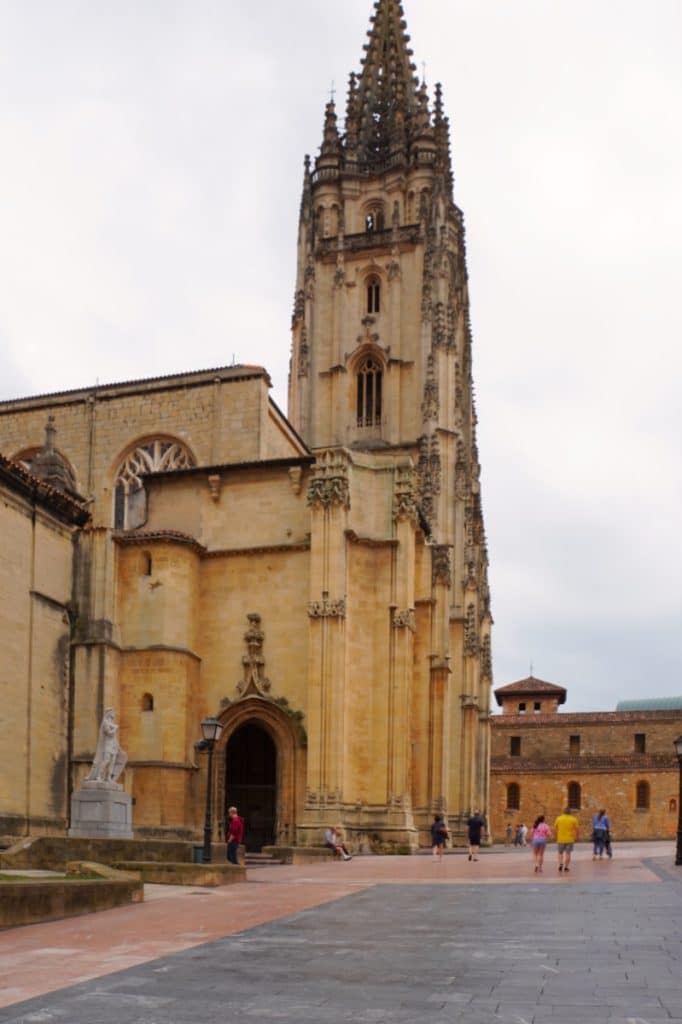
At the end of the 13th century, the Gothic architectural style became increasingly dominant in new buildings. The decision was also made to redesign the cathedral in Oviedeo. Initially, the chapel hall and the cloister were adapted to the new style. It was a good 100 years before the style of the nave was also changed. The work was not completed until the 16th century.

In 1934, there was a major, violent strike by miners in Oveido. They detonated a bomb in the crypt, destroying valuable art treasures and causing damage to the building. Reconstruction continued until 1942, with attempts being made to restore the building to its original state.
Visit to the cathedral of Oveido
If you stand in front of the cathedral today, you can see a façade from the 16th century. The entrance is particularly beautiful, allowing visitors to enter all three naves. A 5-storey tower with a clock dominates the view of the building.
When you enter the church, you stand in a central nave that is a good 20 meters high. The vault rests on bundle pillars. I particularly liked the beautiful stained glass windows in the apse. There are numerous chapels in the side aisles.

The reredos of the main altar particularly caught my eye. It was designed by two artists between 1511 and 1531. At 12 x 12 meters, it really is very large! While I was looking at the individual pictures, I noticed that 24 scenes from the life of Jesus are depicted here.
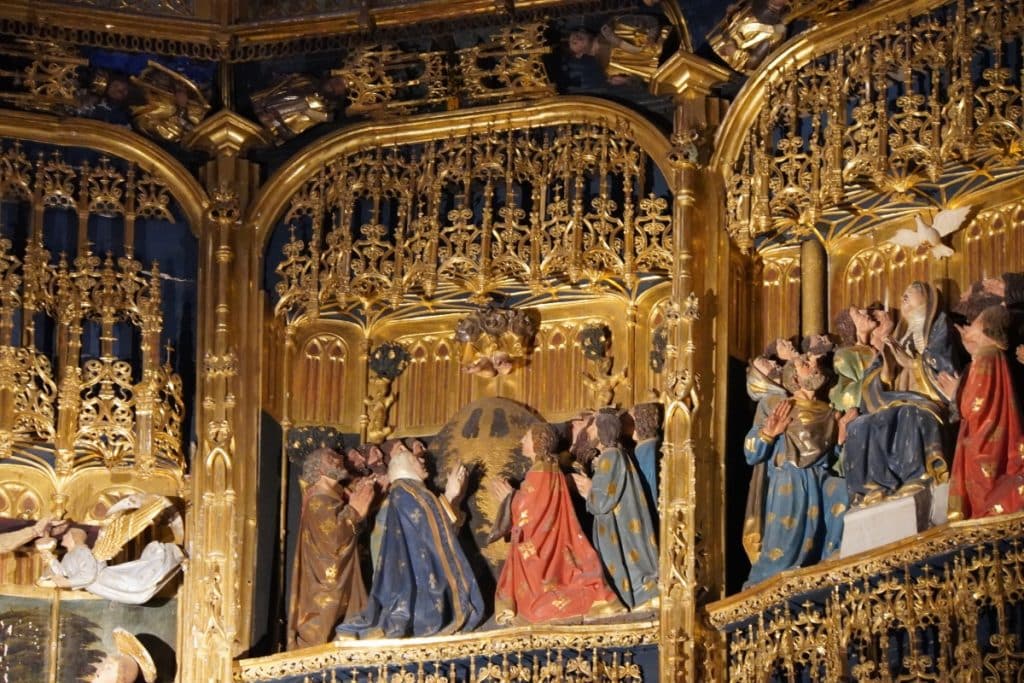
A tour of the cloister is not to be missed. It is rectangular in shape. The longer side has 4 arches, the shorter side 3 arches. The upper floor was only added in the 18th century. The long construction period can be seen in the different architectural styles. There are elements from the Romantic and Baroque periods. I particularly like the strikingly designed capitals. One of them, for example, features a hunting scene.

There is one place in Oviedo Cathedral that is very special. The royal burial place is located here in a chapel that was added later.
In 2015, the cathedral was included in the extension of the UNESCO World Heritage “Way of St. James” in Spain.
Oviedo – a sculpture trail
There are many different ways to visit the city. How about a tour in search of the city’s most beautiful sculptures?
There are around 100 sculptures in Oviedo. I have put together a route that is not too long and, in addition to the beautiful works of art, also offers some insights into life in Oviedo.
Escultura „La Regenta“
Opposite the most famous sight in Oviedo, the cathedral, is the sculpture of a lady. Her appearance is inspired by a character from a 19th century novel (the novel “Clarín” by Leopoldo Alas). The figure was sculpted at the end of the 20th century by Mauro Alvarez Fernandez.
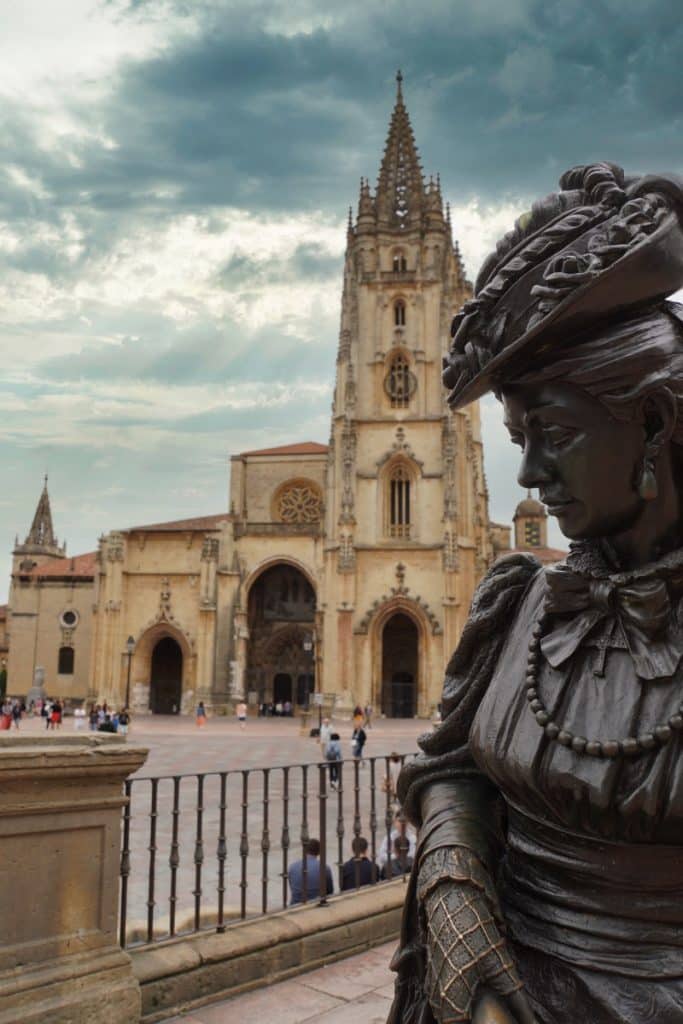
As I stand right next to the woman, I notice that she is slightly taller than the “average woman”. Her features look very lively, almost as if she is walking past and looking at the imposing cathedral in the background.
Escultura „La lechera“
La lechera, which means milkmaid, is located on Trascorrales Square. The work of art was created by the artist Manuel García Linare.
La lechera was created in recognition of the women of the city who carried milk through Ovideo with their donkeys until the 1970s.

I really like the figure. The woman, dressed quite simply, is holding a ladle in her hand. Next to her is a donkey carrying the milk can and drinking from a bucket.
Escultura “El Vendedor de Pescado”
José Antonio García Prieto created the sculpture of the fish seller in 1996, which was erected in Trascorrales Square.
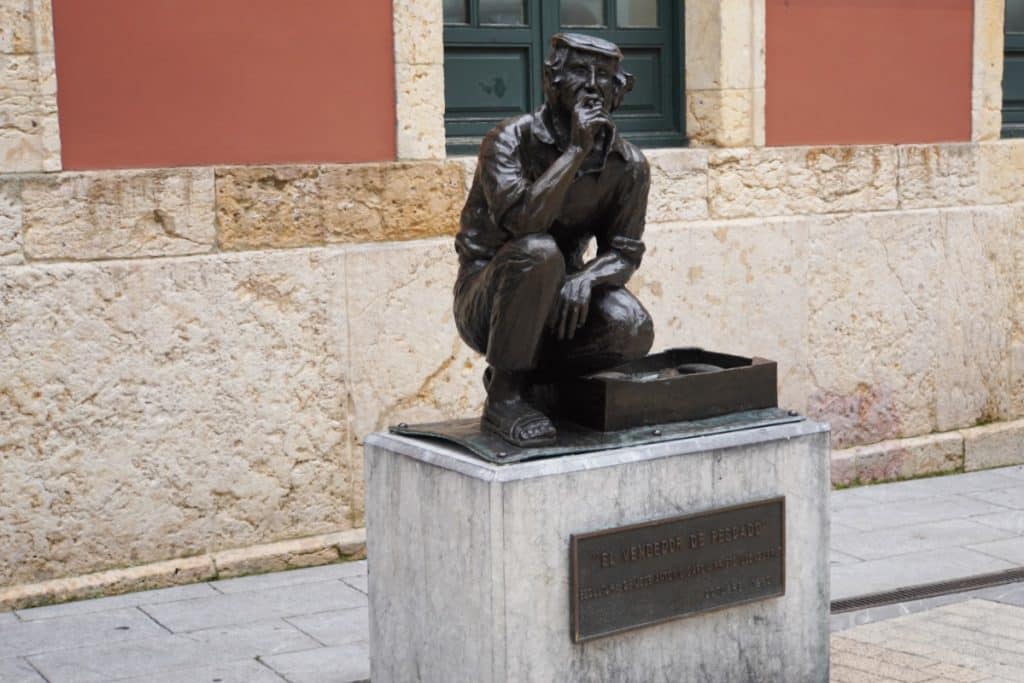
The bronze shows a man squatting in front of a box filled with fish. He represents the typical fishmonger that was once to be found in the city’s markets.
Escultura “Pescadera”
Another sculpture in the Trascorrales square is the fisherwoman. The bronze sculpture is a replica of a smaller work that is part of a series of 10 sculptures. It was created by the artist Sebastián Miranda.

A very pretty woman sits on the street with her fish, looking dreamy. It almost looks as if she is waiting for her customers and dreaming of better times.
Escultura “Vendedoras del Fontán”
Several women stand with their jugs in the Plaza Daoíz y Velarde in Oviedo. The market was held here twice a week, selling agricultural produce, livestock and handicrafts from Asturias. The sculpture “Favila” by artist Amado González Hevia from 1996 is a tribute to the women who sold their goods there.

Escultura „La bella Lola“

The beautiful Lola is sitting on a bench in the Plaza del Fontán and is obviously waiting for something or someone. The figure is a copy of a statue that can be found on the Paseo Marítimo in the city of Torrevieja.
Escultura de Valdés Salas
In the inner courtyard of the University of Oviedo stands a well-known figure. Fernando de Valdés y Salas was the founder of the university.
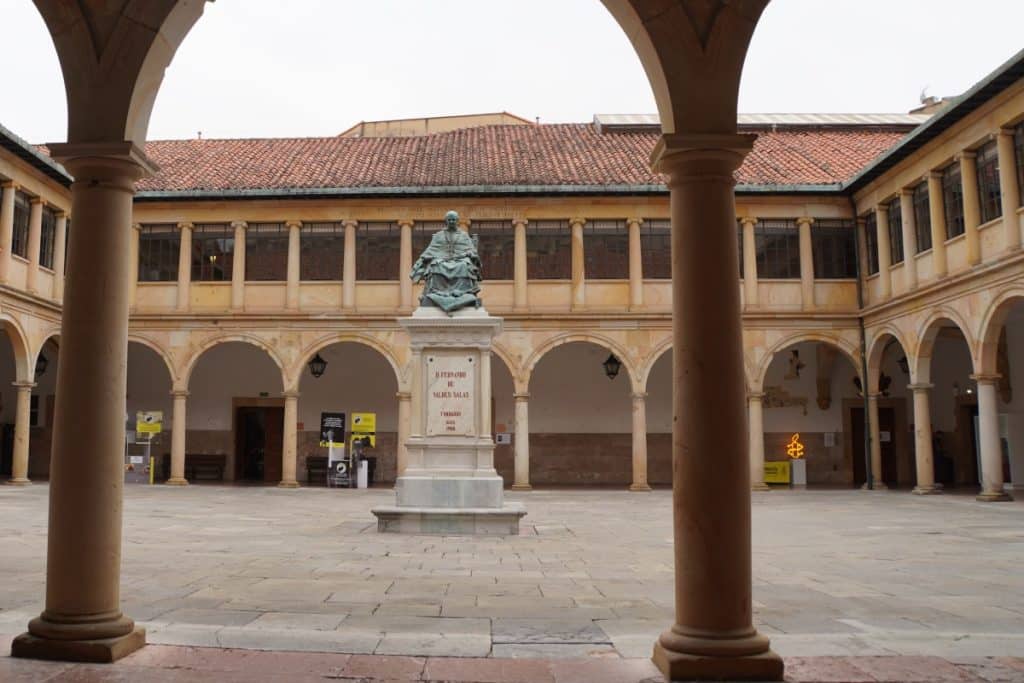
Cipriano Folgueras Doiztúa created the metal sculpture in 1908.
Escultura „El regreso de Williams B. Arrensberg“
“The Return of Williams B. Arrensberg” depicts a traveler standing in the Plaza Porlier. The man is wearing a hat and a coat and is standing on the street with several suitcases and an umbrella. It almost looks as if he has just arrived in the city and is waiting for someone to pick him up.

The bronze sculpture was made by the artist Eduardo Úrculo and shows his friend Williams B. Arrensberg.
Escultura “Mujer sentada”
The “Sitting Woman” is a visually somewhat different work. It has rounded forms and, in my opinion, is not as detailed as other figures that can be seen on the tour.
The bronze sculpture is the work of Manuel Martínez Hugué and dates back to 1930, although it was only erected in front of the university building in 1996.
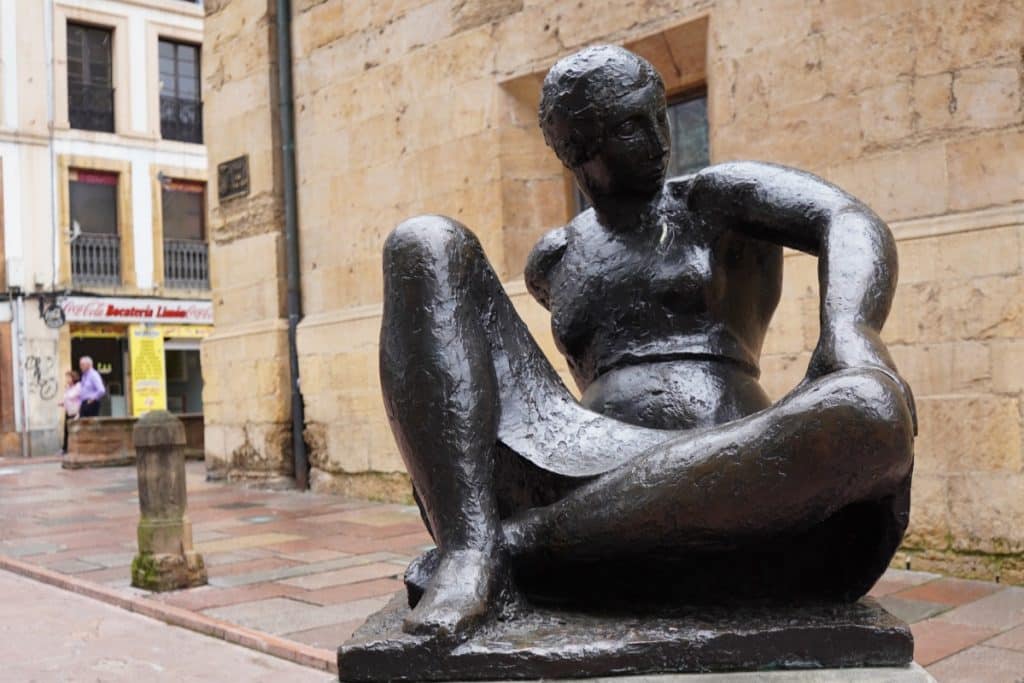
Escultura „Asturcones“
Manuel Valdés Blasco’s work from 2005 shows three horses, which I think look very angular and hard. It is the artist’s first sculpture in which he depicts animals.

I don’t like the animals that much, but the children seem to love them. There was hardly an opportunity to photograph the figure without a child.
Escultura “La Maternidad” de Botero
In contrast to the very angular horses, the woman with child appears very rounded and soft. Almost a symbol of the mother figure.

Escultura “La Encarna con Chiquilín”
In complete contrast, the statue by Sebastián Miranda shows a rather thin woman with a child. The bronze statue stands on the edge of the Campo de San Francisco.

Monumento a José Tartiere
The monument to José Tartiere Lenegre on Paseo de los Álamos, Campo de San Francisco, is one of the more than one hundred urban sculptures that adorn the streets of Oveido.

This monument is a bronze and stone sculpture dating from 1933 and was created by the artists Víctor Hevia and Manuel Álvarez Laviada after the death of the businessman and architect depicted. It was one of the patrons of the region.
Escultura “La Torera”
There is a very popular bronze sculpture on Avenida de Italia del Campo San Francisco. It is a tribute to the photographer Josefa Carril and her husband Antonio Hernández. For many years, they photographed the bourgeoisie of the time at this very spot.

It depicts a laughing Josefa, a tripod and a little horse. She used it to distract the children while they were being photographed. Today, the children like to climb on the horse and have their parents photograph them.
The name “La Torera” is actually very confusing. After all, it is not a bullfighter but a photographer who can be seen. The name refers to the photographer’s shoes, she was wearing a pair of “manoletinas”, which was typical for bullfighters.
Estatua de San Francisco de Asís
In the middle of the Campo de San Francisco in Oviedo stands the statue of St. Francis of Assisi. Enrique del Fresno Guisasola created the stone figure in 1949. He created a reproduction of the famous statue by Pedro de Mena, which can be found in Toledo Cathedral. The saint is dressed in simple clothes and barefoot, with his hands tucked into his sleeves.

Legend has it that Francis of Assisi passed through the town during his pilgrimage on the Way of St. James.
Escultura “Adiós Cordera”
Another sculpture in the Campo de San Francisco shows two children with a cow. Manuel García Linares has depicted a famous story by Leopoldo Alas.
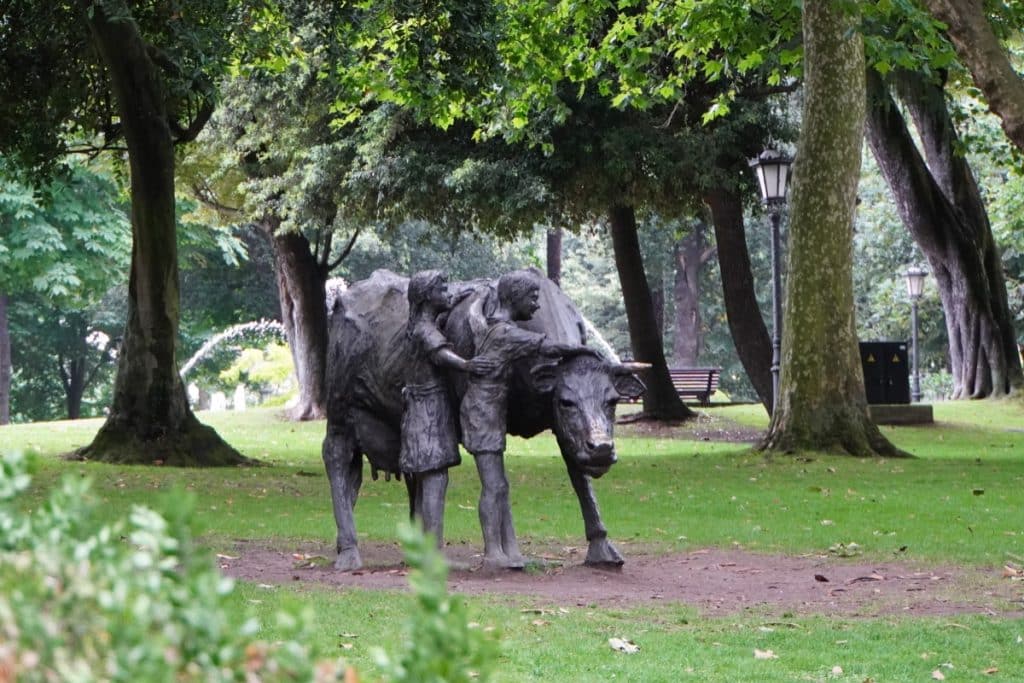
Escultura: Torso Fruela I “Berrocal”
At the intersection of Conde de Toreno and General Yagüe stands a rather modern-looking figure by Miguel Berrocal. On a high pedestal stands a figure made up of several parts, showing a torso. It is said to be a tribute to King Fruela I (757-768), who once sat on the Asturian throne.

The visit to the city took place as part of a press trip with the Costa Verde Express.



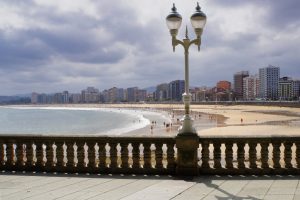



Leave a Reply